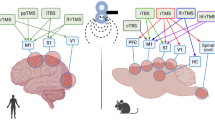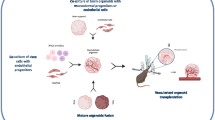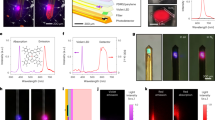Abstract
Postnatal development of the visual cortex is modulated by experience, especially during the critical period. In rats, a stable neuronal population is only acquired after this relatively prolonged period. Vascular endothelial growth factor (VEGF) is the most important angiogenic factor and also has strong neuroprotective, neurotrophic and neurogenic properties. Similar effects have been described for rearing in enriched environments. Our aim is to investigate the vascular and neuronal effects of combining VEGF infusion and environmental enrichment on the visual cortex during the initial days of the critical period. Results showed that a small percentage of Cleaved Caspase-3 positive cells colocalized with neuronal markers. The lesion produced by the cannula implantation resulted in decreased vascular, neuronal and Caspase-3 positive cell densities. Rearing under enriched environment was unable to reverse these effects in any group, whereas VEGF infusion alone partially corrected those effects. A higher effectiveness was reached by combining both the procedures, the most effective combination being when enriched-environment rearing was introduced only after minipump implantation. In addition to the angiogenic effect of VEGF, applied strategies also had synergic neuroprotective effects, and the combination of the two strategies had more remarkable effects than those achieved by each strategy applied individually.






Similar content being viewed by others
References
Acarin L, Villapol S, Faiz M, Rohn TT, Castellano B, Gonzalez B (2007) Caspase-3 activation in astrocytes following postnatal excitotoxic damage correlates with cytoskeletal remodeling but not with cell death or proliferation. Glia 55:954–965
Argandoña EG, Lafuente JV (1996) Effects of dark-rearing on the vascularization of the developmental rat visual cortex. Brain Res 732:43–51
Argandoña EG, Lafuente JV (2000) Influence of visual experience deprivation on the postnatal development of the microvascular bed in layer IV of the rat visual cortex. Brain Res 855:137–142
Argandoña EG, Bengoetxea H, Lafuente JV (2005) Lack of experience-mediated differences in the immunohistochemical expression of blood-brain barrier markers (EBA and GluT-1) during the postnatal development of the rat visual cortex. Brain Res Dev Brain Res 156:158–166
Argandoña EG, Bengoetxea H, Lafuente JV (2009) Physical exercise is required for environmental enrichment to offset the quantitative effects of dark-rearing on the S-100beta astrocytic density in the rat visual cortex. J Anat 215:132–140
Bengoetxea H, Argandoña EG, Lafuente JV (2008) Effects of visual experience on vascular endothelial growth factor expression during the postnatal development of the rat visual cortex. Cereb Cortex 18:1630–1639
Black JE, Isaacs KR, Anderson BJ, Alcantara AA, Greenough WT (1990) Learning causes synaptogenesis, whereas motor activity causes angiogenesis, in cerebellar cortex of adult rats. Proc Natl Acad Sci USA 87:5568–5572
Cancedda L, Putignano E, Sale A, Viegi A, Berardi N, Maffei L (2004) Acceleration of visual system development by environmental enrichment. J Neurosci 24:4840–4848
D′Amelio M, Cavallucc V, Cecconi F (2010) Neuronal Caspase-3 signaling; not only cell death. Cell Death Differ 17:1104–1114
Dvorak HF (2000) VPF/VEGF and the angiogenic response. Semin Perinatol 24:75–78
Fagiolini M, Hensch TK (2000) Inhibitory threshold for critical-period activation in primary visual cortex. Nature 404:183–186
Fagiolini M, Pizzorusso T, Berardi N, Domenici L, Maffei L (1994) Functional postnatal development of the rat primary visual cortex and the role of visual experience: dark rearing and monocular deprivation. Vision Res 34:709–720
Ferrara N, Gerber HP, LeCouter J (2003) The biology of VEGF and its receptors. Nat Med 9:669–676
Finlay BL (1992) Cell death and the creation of regional differences in neuronal numbers. J Neurobiol 23:1159–1171
Gulyaeva NV (2003) Non-apoptotic functions of caspase-3 in nervous tissue. Biochemistry (Mosc) 68:1171–1180
Hawkins BT, Davis TP (2005) The blood-brain barrier/neurovascular unit in health and disease. Pharmacol Rev 57:173–185
Hensch TK (2005) Critical period plasticity in local cortical circuits. Nat Rev Neurosci 6:877–888
Ickes BR, Pham TM, Sanders LA, Albeck DS, Mohammed AH, Granholm AC (2000) Long-term environmental enrichment leads to regional increases in neurotrophin levels in rat brain. Exp Neurol 164:45–52
Jin K, Zhu Y, Sun Y, Mao XO, Xie L, Greenberg DA (2002) Vascular endothelial growth factor (VEGF) stimulates neurogenesis in vitro and in vivo. Proc Natl Acad Sci USA 99:11946–11950
Lafuente JV, Mitre B, Argandoña EG (2007) Spatio-temporal distribution of apoptosis and the modulators thereof following a cortical microinfarct in rat brain. Neurosci Res 57:354–361
Li Z, Jo J, Jia JM, Lo SC, Withcomb DJ et al (2010) Caspase-3 activation via mitochondria is required for long-term depression and AMPA receptor internalization. Cell 141:859–871
Lok J, Gupta P, Guo S, Kim WJ, Whalen MJ, van LK, Lo EH (2007) Cell-cell signaling in the neurovascular unit. Neurochem Res 32:2032–2045
McCoy PA, Huang HS, Philpot BD (2009) Advances in understanding visual cortex plasticity. Curr Opin Neurobiol 19:298–304
McLaughlin B (2004) The kinder side of killer proteases: caspase activation contributes to neuroprotection and CNS remodeling. Apoptosis 9:111–121
Mellios K, Zacharaki T, Sophou S, Latsari M, Antonopoulos J, Dinopoulos A, Parnavelas JG, Dori I (2009) Natural and lesion-induced apoptosis in the rat striatum during development. Brain Res 1252:30–44
Nicotera P, Leist M, Fava E, Berliocchi L, Volbracht C (2000) Energy requirement for caspase activation and neuronal cell death. Brain Pathol 10:276–282
Nithianantharajah J, Hannan AJ (2009) The neurobiology of brain and cognitive reserve: mental and physical activity as modulators of brain disorders. Prog Neurobiol 89:369–382
Nithianantharajah J, Levis H, Murphy M (2004) Environmental enrichment results in cortical and subcortical changes in levels of synaptophysin and PSD-95 proteins. Neurobiol Learn Mem 81:200–210
Ooman S, Finckbone V, Dertien J, Attridge J, Henne W et al (2004) Active caspase-3 expression during postnatal development of rat cerebellum is not systematically or consistently associated with apoptosis. J Comp Neurol 476:154–173
Paban V, Chambon C, Manrique C, Touzet C, Alescio-Lautier B (2009) Neurotrophic signaling molecules associated with cholinergic damage in young and aged rats. Environmental enrichment as potential therapeutic agent. Neurobiol Aging. doi:10.1016/jneurobiolaging.2009.03.010
Papadopoulos GC, Michaloudi HC (1999) Apoptosis in the visual system of normal and dark-reared rats. Brain Res 838:214–217
Pham TM, Winblad B, Granholm AC, Mohammed AH (2002) Environmental influences on brain neurotrophins in rats. Pharmacol Biochem Behav 73:167–175
Rohn TT, Cusack SM, Kessinger SR, Oxford JT (2004) Caspase activation independent of cell death is required for proper cell dispersal and correct morphology in PC12 cells. Exp Cell Res 295:215–225
Rosenstein JM, Krum JM (2004) New roles for VEGF in nervous tissue—beyond blood vessels. Exp Neurol 187:246–253
Sanchez C, Diaz-Nido J, Avila J (2000) Phosphorylation of microtubule-associated proteína 2 (MAP2) and its relevance for the regulation of the neuronal cytoskeleton function. Prog Neurobiol 61:133–168
Storkebaum E, Lambrechts D, Carmeliet P (2004) VEGF: once regarded as a specific angiogenic factor, now implicated in neuroprotection. Bioessays 26:943–954
Unal-Cevik I, Kilinc M, Gursoy-Ozdemir Y, Gurer G, Dalkara T (2004) Loss of NeuN immunoreactivity after cerebral ischemia does not indicate neuronal cell loss: a cautionary note. Brain Res 1015:169–174
Zacchigna S, Lambrechts D, Carmeliet P (2008) Neurovascular signalling defects in neurodegeneration. Nat Rev Neurosci 9:169–181
Acknowledgments
This study has been supported by the Gangoiti Foundation, SAIOTEK (Dpt. Industry, Government of the Basque Country) and IT/491/10 (Basque Government). N. Ortuzar is supported by a predoctoral grant (FPU) from the Spanish Ministry of Education. Confocal microscopy analysis was performed at the “Servicio de Microscopia Analítica y de Alta Resolución en Biomedicina” (High Resolution Analytical Microscopy Services for Biomedicine) at the University of the Basque Country.
Conflict of interest
The authors declare that they have no conflict of interest.
Author information
Authors and Affiliations
Corresponding author
Rights and permissions
About this article
Cite this article
Ortuzar, N., Argandoña, E.G., Bengoetxea, H. et al. Combination of intracortically administered VEGF and environmental enrichment enhances brain protection in developing rats. J Neural Transm 118, 135–144 (2011). https://doi.org/10.1007/s00702-010-0496-2
Received:
Accepted:
Published:
Issue Date:
DOI: https://doi.org/10.1007/s00702-010-0496-2




